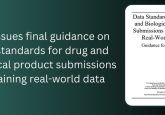FDA issues latest RWD/RWE draft guidance on the use of externally controlled trials

The new draft guidance released by the FDA provides recommendations to sponsors and researchers who are seeking to use externally controlled trials to generate evidence on the safety and effectiveness of a drug product.
The US Food and Drug Administration (FDA) has issued a new draft guidance concerning the use of externally controlled trials in generating the evidence for new drugs and biological products to support regulatory decision-making. One of a series of guidance documents provided by the FDA under its Real-World Evidence (RWE) Program, the new document, entitled “Considerations for the Design and Conduct of Externally Controlled Trials for Drug and Biological Products”, provides the current thinking by the agency on the topic and is open for feedback before the final version of the guidance is completed.
Externally controlled clinical trials are more increasingly being used to evaluate the efficacy and safety of new treatments or interventions compared to existing ones, and to provide evidence-based recommendations for patient care. As defined by the FDA, in externally controlled trials, “outcomes in participants receiving the test treatment according to a protocol are compared to outcomes in a group of people external to the trial who had not received the same treatment. The external control arm can be a group of people, treated or untreated, from an earlier time (historical control), or it can be a group of people, treated or untreated, during the same time period (concurrent control) but in another setting”.
The draft guidance provides stakeholders with considerations on the design and analysis of externally controlled trials, with emphasis placed on the design phase of such studies including how to measure and analyze data on important confounding factors and sources of bias, which can impact the validity of trial results. The external control arm populations should be as similar as possible to the study treatment populations with regards to known factors that can affect the outcomes being measured, which includes baseline characteristics of participants, disease attributes and the clinical outcomes measured. The patient-level data used in the control arms should come from other clinical trials or real-world data (RWD) sources, such as registries, electronic health records, and medical claims.
The guidance also covers considerations for communicating with the FDA about whether it is reasonable to conduct an externally controlled trial instead of a randomized controlled trial. It is also recommended that stakeholders ensure the FDA has full access to relevant patient-level data, source documents and source data, which must be included in marketing applications.
The guidance is open for comment until May 2nd 2023.
Want regular updates on the latest real-world evidence news straight to your inbox? Become a member on The Evidence Base® today>>>






